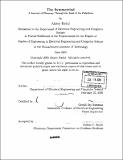| dc.contributor.advisor | Gerald Jay Sussman. | en_US |
| dc.contributor.author | Radul, Alexey | en_US |
| dc.contributor.other | Massachusetts Institute of Technology. Dept. of Electrical Engineering and Computer Science. | en_US |
| dc.date.accessioned | 2006-07-13T15:16:23Z | |
| dc.date.available | 2006-07-13T15:16:23Z | |
| dc.date.copyright | 2005 | en_US |
| dc.date.issued | 2005 | en_US |
| dc.identifier.uri | http://hdl.handle.net/1721.1/33337 | |
| dc.description | Thesis (M. Eng.)--Massachusetts Institute of Technology, Dept. of Electrical Engineering and Computer Science, 2005. | en_US |
| dc.description | Includes bibliographical references (p. 111). | en_US |
| dc.description.abstract | I devised and implemented a method for constructing regular and semiregular geometric objects in n-dimensional Euclidean space. Given a finite reflection group (a Coxeter group) G, there is a standard way to give G a group action on n-space. Reflecting a point through this group action yields an object that exhibits the symmetries specified by G. If the point is chosen well, the object is guaranteed to be regular or semiregular, and many interesting regular and semiregular objects arise this way. By starting with the symmetry group, I can use the group structure both to simplify the actual graphics involved with displaying the object, and to illustrate various aspects of its structure. For example, subgroups of the symmetry group (and their cosets) correspond to substructures of the object. Conversely, by displaying such symmetric objects and their various substructures, I find that I can elucidate the structure of the symmetry group that gives rise to them. I have written The Symmetriad, the computer system whose name this document has inherited, and used it to explore 3- and 4-dimensional symmetric objects and their symmetry groups. The 3-dimensional objects are already well understood, but they serve to illustrate the techniques used on the 4-dimensional objects and make them more comprehensible. Four dimensions offers a treasure trove of intriguing structures, many of which have no ready 3D analogue. These are what I will show you here. | en_US |
| dc.description.statementofresponsibility | by Alexey Radul. | en_US |
| dc.format.extent | 111 p. | en_US |
| dc.format.extent | 5561923 bytes | |
| dc.format.extent | 5566514 bytes | |
| dc.format.mimetype | application/pdf | |
| dc.format.mimetype | application/pdf | |
| dc.language.iso | eng | en_US |
| dc.publisher | Massachusetts Institute of Technology | en_US |
| dc.rights | M.I.T. theses are protected by copyright. They may be viewed from this source for any purpose, but reproduction or distribution in any format is prohibited without written permission. See provided URL for inquiries about permission. | en_US |
| dc.rights.uri | http://dspace.mit.edu/handle/1721.1/7582 | |
| dc.subject | Electrical Engineering and Computer Science. | en_US |
| dc.title | The Symmetriad : a journey of discovery through the land of the polychora | en_US |
| dc.type | Thesis | en_US |
| dc.description.degree | M.Eng. | en_US |
| dc.contributor.department | Massachusetts Institute of Technology. Department of Electrical Engineering and Computer Science | |
| dc.identifier.oclc | 62367690 | en_US |
